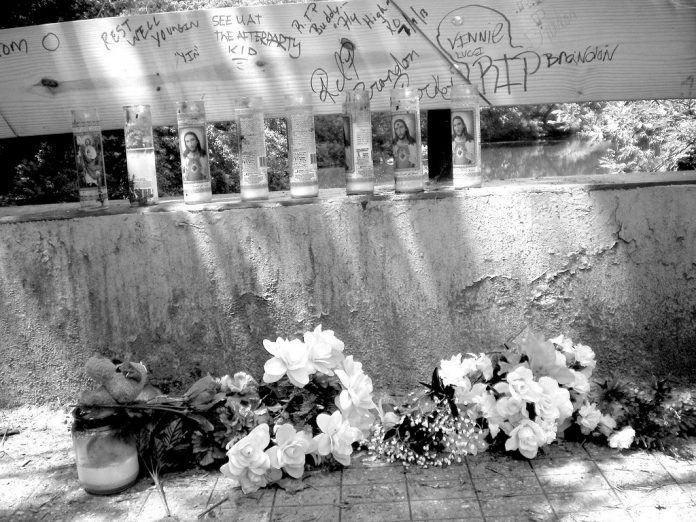A memorial: Flowers and candles are left on the footbridge over the Pennypack Creek where Brandon Boyle lost his life when he jumped into the pool below.
Last Thursday afternoon, when the mercury rose to 97 degrees, the pool of water above the dam in the Pennypack Creek in Bustleton remained inviting but unbroken.
Three boys waded in the water downstream from the “boulevard dam” and a girl sat on rocks nearby and gazed at the waterfall, but no one swam in the pool above the dam or used the footbridge spanning the creek as a diving board.
The dam is one of only two left on the Pennypack and no longer serves any purpose. Instead, the four-foot-high stone and masonry barrier creates the lovely falls and the swimming hole — and a temptation too difficult for young people to ignore.
It’s time to remove that temptation before another life is lost. We’ve reported that five young people have been killed or imperiled at the spot over the last three years.
Enough is enough.
The most recent casualty occurred July 1 when a Bell’s Corner boy, 13-year-old Brandon Boyle, flew from the bridge and into the rain-swollen creek. His brother, Anthony, 11, also jumped into the water, and had to be rescued. Brandon’s body was found along the banks on July 4.
His death was the second tragedy at the bridge in recent memory. Saulius Kvaraciejus, 20, tried to ride an inflatable pool over the dam in July 2010, but disappeared from view. Both fatalities occurred after storms when the creek becomes a torrent of water and a stew of debris.
Trouble was averted earlier this summer when police rescued two young people who had been swimming in the creek.
Although no swimming is allowed, and public swimming pools are open, it is hard for kids to ignore the idyllic Norman Rockwell-like setting on a hot summer day.
As Brandon’s uncle, Michael Boyle, told the Northeast Times , “Kids swim in creeks. That’s what they do. But that bridge is almost an invitation … and kids are fearless.”
The dam, like others along the creek, had once been vital to the economy of the region. It created a pool of water above the barrier, and that water was rerouted to serve a factory or mill along the waterway.
To get something done, we approached City Councilman Brian O’Neill about the possibility of tearing down the dam, and removing the lure of the swimming hole. His reconfigured district will soon include this section of the city, and he said he definitely would support removal of the dam.
Checking further, with Joanne Dahme of the city’s Water Department, we learned that removing the dam wouldn’t be simple or cheap. She said the removal of Huntingdon Dam on the Pennypack in Montgomery County cost about $100,000 in 2007, and estimated a similar cost to this dam.
The site is about a 10-minute walk down a paved path off Winchester Avenue at Woodward Street. Heavy equipment would have to be brought in, a temporary road built, engineering studies done. Add in permit costs, dredging, sediment removal and more. The list goes on.
It would require cooperation among the city Parks and Recreation and Water departments as well as the state Department of Environmental Protection and the U.S. Army Corps of Engineers.
Another, more cost-effective solution could be cutting a sluice in the dam to keep the pool from building. That would have the added benefit of allowing hickory shad and river herring to swim upstream.
And there is a third, even less costly solution. The city could install a rounded, cagelike fence atop the bridge, like those found on bicycle paths over busy highways. That would prevent people from jumping from the bridge.
The very first thing that should be done is to remove the dozen or so wooden planks that create a quick path up a tree on the far bank. The branches extend over the water and create a clear shot over the swimming hole.
Today, the footbridge has become a small shrine to the life of young Brandon Boyle. Eight votive candles and a dozen sprays of flowers line one side. A sign pays tribute and a black Sharpie marker invites visitors to leave messages.
“RIP Brandon,” “Fly high” and “Do not swim” are reminders that a young boy made a bad decision and it cost him his life.
It’s up to us, the grownups, to say that not one more life will be taken or imperiled. We have many good ways to make this temptation disappear. Let’s not lose this opportunity to save fearless kids from themselves. Who will join in? ••





